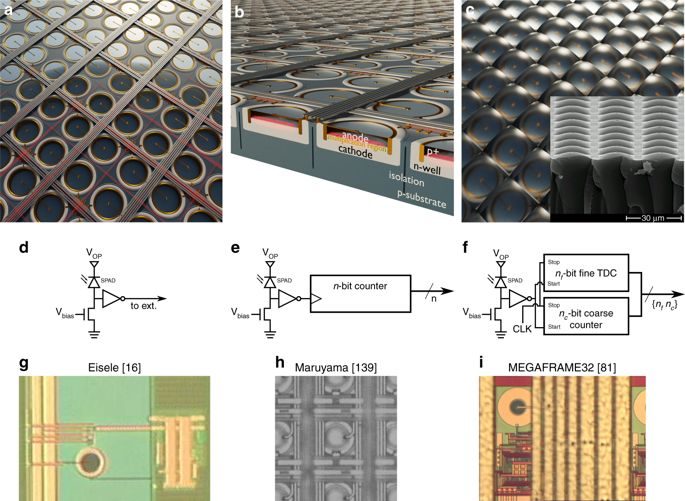当前位置:
X-MOL 学术
›
Light Sci. Appl.
›
论文详情
Our official English website, www.x-mol.net, welcomes your feedback! (Note: you will need to create a separate account there.)
Single-photon avalanche diode imagers in biophotonics: review and outlook.
Light: Science & Applications ( IF 19.4 ) Pub Date : 2019-09-18 , DOI: 10.1038/s41377-019-0191-5 Claudio Bruschini 1 , Harald Homulle 2 , Ivan Michel Antolovic 1 , Samuel Burri 1 , Edoardo Charbon 1
Light: Science & Applications ( IF 19.4 ) Pub Date : 2019-09-18 , DOI: 10.1038/s41377-019-0191-5 Claudio Bruschini 1 , Harald Homulle 2 , Ivan Michel Antolovic 1 , Samuel Burri 1 , Edoardo Charbon 1
Affiliation

|
Single-photon avalanche diode (SPAD) arrays are solid-state detectors that offer imaging capabilities at the level of individual photons, with unparalleled photon counting and time-resolved performance. This fascinating technology has progressed at a very fast pace in the past 15 years, since its inception in standard CMOS technology in 2003. A host of architectures have been investigated, ranging from simpler implementations, based solely on off-chip data processing, to progressively "smarter" sensors including on-chip, or even pixel level, time-stamping and processing capabilities. As the technology has matured, a range of biophotonics applications have been explored, including (endoscopic) FLIM, (multibeam multiphoton) FLIM-FRET, SPIM-FCS, super-resolution microscopy, time-resolved Raman spectroscopy, NIROT and PET. We will review some representative sensors and their corresponding applications, including the most relevant challenges faced by chip designers and end-users. Finally, we will provide an outlook on the future of this fascinating technology.
中文翻译:

生物光子学中的单光子雪崩二极管成像仪:回顾和展望。
单光子雪崩二极管 (SPAD) 阵列是固态探测器,可提供单个光子级别的成像功能,具有无与伦比的光子计数和时间分辨性能。自 2003 年标准 CMOS 技术问世以来,这项令人着迷的技术在过去 15 年里以非常快的速度发展。人们对许多架构进行了研究,从仅基于片外数据处理的更简单的实现,到逐步发展的架构。 “更智能”的传感器包括片上、甚至像素级、时间戳和处理能力。随着技术的成熟,一系列生物光子学应用得到了探索,包括(内窥镜)FLIM、(多束多光子)FLIM-FRET、SPIM-FCS、超分辨率显微镜、时间分辨拉曼光谱、NIROT 和 PET。我们将回顾一些代表性传感器及其相应的应用,包括芯片设计者和最终用户面临的最相关的挑战。最后,我们将对这项令人着迷的技术的未来进行展望。
更新日期:2019-09-18
中文翻译:

生物光子学中的单光子雪崩二极管成像仪:回顾和展望。
单光子雪崩二极管 (SPAD) 阵列是固态探测器,可提供单个光子级别的成像功能,具有无与伦比的光子计数和时间分辨性能。自 2003 年标准 CMOS 技术问世以来,这项令人着迷的技术在过去 15 年里以非常快的速度发展。人们对许多架构进行了研究,从仅基于片外数据处理的更简单的实现,到逐步发展的架构。 “更智能”的传感器包括片上、甚至像素级、时间戳和处理能力。随着技术的成熟,一系列生物光子学应用得到了探索,包括(内窥镜)FLIM、(多束多光子)FLIM-FRET、SPIM-FCS、超分辨率显微镜、时间分辨拉曼光谱、NIROT 和 PET。我们将回顾一些代表性传感器及其相应的应用,包括芯片设计者和最终用户面临的最相关的挑战。最后,我们将对这项令人着迷的技术的未来进行展望。



























 京公网安备 11010802027423号
京公网安备 11010802027423号